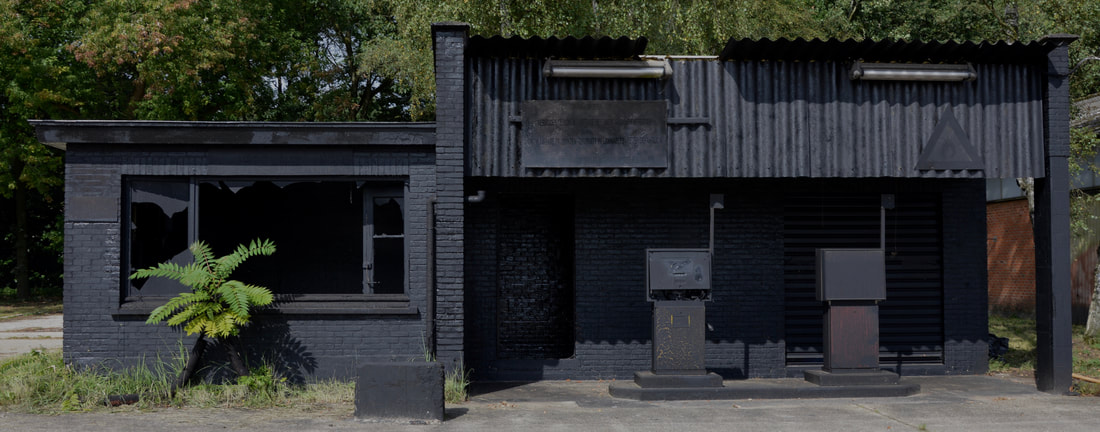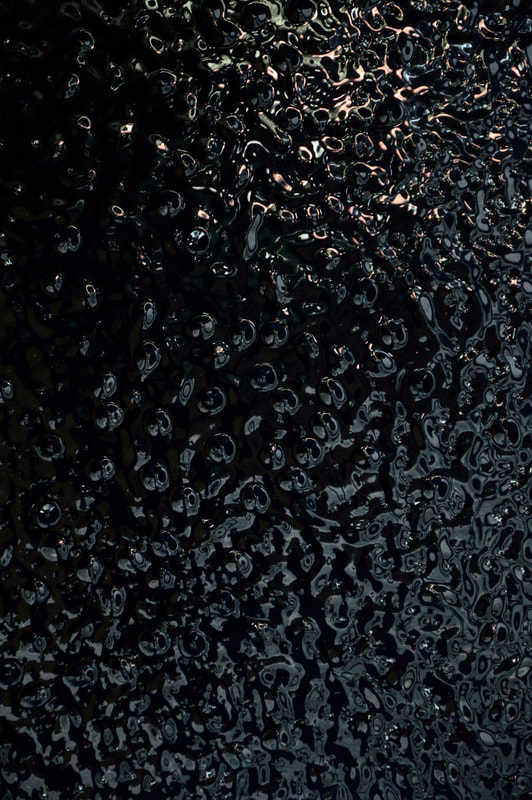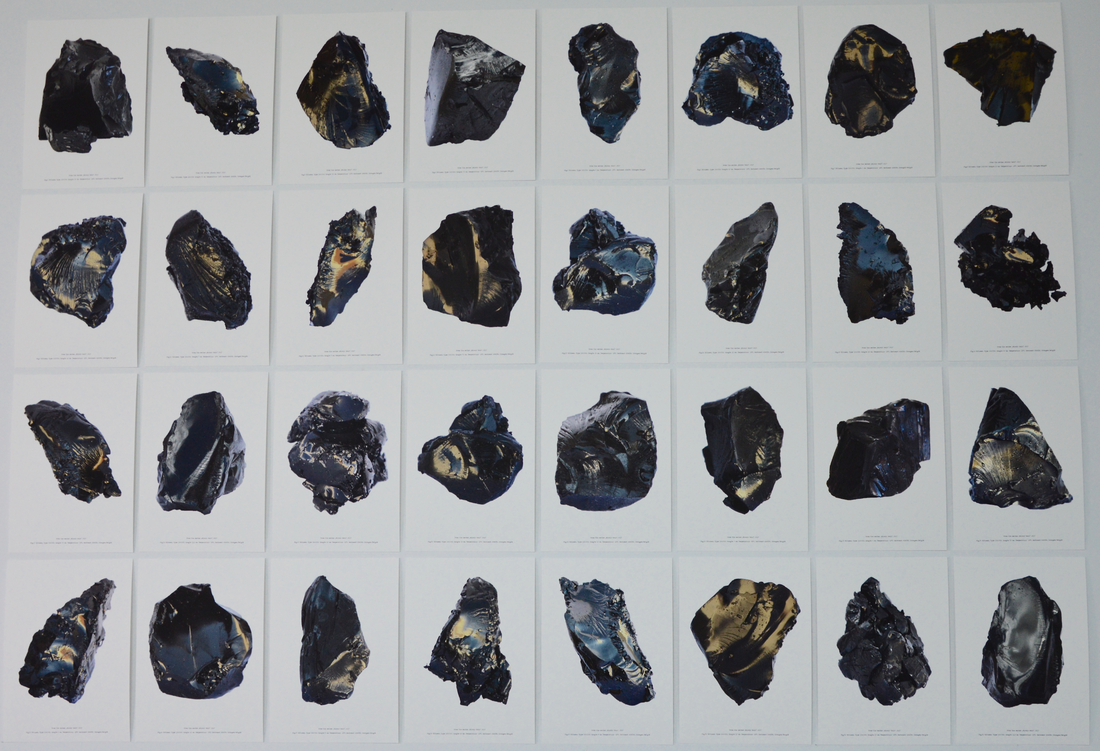|
MIROIR NOIR
In situ installation at Campus Coppens site, 2017 till unpredictable time (bitumen emulsion) From the series MIROIR NOIR Bitumina, 2017
Edition / Digital photo series, 32 figures (-15°C) Printed on Museum etching paper, 350 g, 29.7X 21 cm , From the series MIROIR NOIR, digital print (dimensions variable)
From the series MIROIR NOIR Bitumina, 2017
Edition / Digital photo series, 32 figures (-15°C) Printed on Museum etching paper, 350 g, 29.7X 21 cm |
MIROIR NOIR (ENG) In situ installation at Campus Coppens site, Brasschaat Antwerpen BE 2017 -till unpredictable time (bitumen emulsion) free entrance 24/24 Brasschaat’s Campus Coppens is an old military site located 20 km from the port of Antwerp (1) and its petrochemical cluster The derelict gas station at Campus Coppens, a remnant of the site’s military history, is a banal archetype that simultaneously recalls modernist functional architecture (2) and the post-war era of increasing prosperity driven by the oil industry. Thanks to the special properties of bitumen (3) the gas station Miroir Noir is not a finished product but a constantly evolving work, as the material remains susceptible to the impact of climatic aspects. Miroir Noir is both a reflection of and witness to the (in)visible processes (4) of change in which we are all entangled: political, economic, climatological and ecological waves propelled by history. 1. Antwerp has the second largest refinery complex in the world, after Houston. The industry in Belgium is very "carbon intensive". 2. Arne Jacobsen’s Texaco gas station ‘Paddehattene’ (1938) represented a new type of service developed in response to increasing automobile traffic. Instead building a gas station according to classic architectonic ideals, Jacobsen resorted to functionalism’s cool, sleek formal language. 3. Bitumen (commonly known as tar): a viscous, dark substance made largely of hydrocarbons contained in crude oil. Bitumen can also occur naturally, without human intervention. In terms of physics it is a liquid, but at ambient temperature has the properties of a solid. At higher temperatures, its fluidity increases; at extremely low temperatures, it can transition from visco-elastic behaviour to that of hard, brittle glass that breaks easily. The earliest written mention of bitumen, or kupru, occurs in the Sumerian epic of Gilgamesh (c. 2100 BC). The hero Gilgamesh tells how the God Ea commissioned him to build an ark as protection against the coming deluge, and to smear it inside and out with kupru. 4. The pitch drop experiment started in 1927, the longest-running scientific experiment in the world. (http://smp.uq.edu.au/content/pitch-drop-experiment) MIROIR NOIR. In the 18th century, a portable round, convex mirror with a black underground was used by painters, tourists and poets as an aid for viewing the landscape. If you stood with your back to the landscape you wished to admire, you saw an image in the mirror that differed from reality. A broader field of vision with fewer details and colour effects that recall the palette of Claude Lorrain.One saw the world as one wanted to see it. An idealised world. MIROIR NOIR. The Aztecs venerated Tezcatlipoca: the god of war. His attribute was a black obsidian mirror. MIROIR NOIR. Because of its distorting, misleading characteristics, the black convex mirror was temporarily associated in the West with the devil. Those found with one in their possession were accused of witchcraft. MIROIR NOIR. In some cultures, tar was heated in order to be used as a black mirror during certain divination rituals to read the present, past and future. MIROIR NOIR NDL In situ installatie Campus Coppens site, Brasschaat Antwerpen BE 2017-tot onvoorspelbare tijd (bitumen emulsie) vrije toegang 24/24 Campus Coppens is een oude militaire site gelegen te Brasschaat op 20 km van de haven van Antwerpen (1) en haar petrochemische cluster. Het verlaten tankstation van Campus Coppens, stille getuige van de militaire geschiedenis van de site, vertoont een doorsnee archetypisch karakter dat tegelijkertijd herinnert aan de functionele modernistische architectuur (2) en het na-oorlogse tijdperk dat gekenmerkt was door de steeds groeiende welvaart, aangedreven door de olieindustrie. De bijzondere eigenschappen van bitumen (3), maken van het tankstation Miroir Noir geen afgewerkt product maar een voortdurend evoluerend werk: het aangebracht materiaal blijft immers gevoelig voor klimatologische condities. Miroir Noir is tegelijk een bespiegeling en een getuige van de (on)zichtbare processen van historische veranderingen (4) die we beleven in de politieke, economische, klimatologische en ecologische golfbewegingen. 1. Antwerpen heeft het op één na grootste raffinaderijcomplex ter wereld, na Houston. De industrie in België is zeer "koolstofintensief". 2. Arne Jacobsen's benzinestation (1938) Paddehattene.De groei in de autoproductie en de aanwas van het autoverkeer leidden naar de vraag van volledig nieuwe voorzieningen en diensten – waaronder het tankstation. Niet de klassieke architectonische idealen maar het functionalisme met zijn nieuwe strakke vormentaal lagen aan de grondslag van dit nieuw standaardtype tankstation. 3. Bitumen in de volksmond teer, is een visceus donker mengsel van verschillende koolwaterstoffen die voorkomen in ruwe aardolie. Bitumen kan zich ook in de natuur vormen zonder tussenkomst van de mens. Natuurkundig gezien is het een vloeistof, maar afhankelijk van de omgevingstemperatuur heeft het ook de eigenschappen van een vaste stof. Bij hogere temperaturen neemt de vloeibaarheid toe; bij extreme koude temperaturen kan het materiaal overgaan van visco-elastisch naar hard broos en makkelijk breekbaar glas. De oudste schriftelijke vermelding van bitumen, of kupru, komt voor in het Sumerische Gilgamesj epos (ca.2100 v.Chr). De held Gilgamesj vertelt hoe de God Ea hem opdracht om een ark te bouwen tegen de verwachte zondvloed, waarvan binnen- en buitenwand met kupru moest worden ingestreken. 4. Het pekdruppelexperimentOpgestart in 1927, is dit het langstlopende wetenschappelijke experiment ter wereld. https://newscientist.nl/nieuws/pekdruppel-voor-het-eerst-op-video-vastgelegd/ MIROIR NOIR. In de 18de Eeuw werd een ronde, convexe handspiegel met zwart achtergrond o.a. door schilders,toeristen en dichters gebruikt om naar het landschap te kijken. Met de rug naar een te bewonderen landschap, zag je in de spiegel een ander beeld van de realiteit: een breder gezichtsveld met weinig details en kleureffecten die het kleurenpalet van Claude Lorrain opriepen. Men zag de wereld zoals men hem graag wilde zien, een geïdealiseerde wereld. MIROIR NOIR. De Azteken vereerde Tezcatlipoca: de god van oorlog. Zijn attribuut is een spiegel in zwarte obsidiaan. MIROIR NOIR. In het Westen werd de zwarte convexe spiegel door zijn vervormende misleidende eigenschappen, voor enige tijd geassocieerd met de duivel. Wie er één bezat, werd beschuldigd van hekserij. MIROIR NOIR. In sommige culturen werd teer verwarmd om als zwarte spiegel te gebruiken in het ritueel waarzeggen over heden, verleden en toekomst. |


